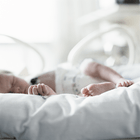Printed from acutecaretesting.org
October 2009
Neonatal jaundice - detection and treatment thresholds
Summarized from Keren R, Tremont K, Luan X, Cnaan A. Visual assessment of jaundice in term and late preterm infants. Arch Dis Child Neonatal Ed 2009; 94 F317-22. Authors: Rennie J, Sehgal A, De A, Kendall G, Cole T. Range of UK practice regarding thresholds for phototherapy and exchange transfusion in neonatal hyperbilirubinaemia. Arch Dis Child Neonatal Ed 2009; 94 F323-27
Neonatal jaundice is the subject of two recent studies and an accompanying editorial, all published in the October issue of Archives of Disease in Childhood (Neonatal Edition). The aim of the first study was to determine if visual assessment of jaundice on day 2-3 of life is accurate in estimating serum bilirubin and predicting the risk of significant hyperbilirubinemia.
With a study population of 555 predominantly full-term healthy neonates, this is one of the largest studies to address this issue. Nurses were charged with assessment of jaundice, which was graded on a 0-5 scale, dependent on the extent of jaundice progression from head to hands and feet (cephalocaudal progression).
Serum bilirubin was measured by transcutaneous bilirubinometry or laboratory measurement within 8 hours of visual assessment. All babies were followed up and those developing significant hyperbilirubinemia identified.
The two principal findings of the study were that the grade of jaundice correlated poorly with serum bilirubin concentration, and the complete absence of jaundice (grade 0) had excellent negative predictive value (99 %) for ruling out significant hyperbilirubinemia. The authors conclude that visual assessment of jaundice cannot be used to estimate serum bilirubin.
The finding of complete absence of jaundice (grade 0) is, however, useful; it indicates an ‘exceedingly low risk’ of developing significant hyperbilirubinemia.
Treatment of neonatal jaundice was the focus of the second study. This was a survey of UK hospitals designed to assess the degree of consensus regarding choice of serum bilirubin thresholds used to trigger the two treatment options: phototherapy and exchange transfusion.
The authors of the study requested a copy of local guidelines for the management of neonatal jaundice from lead clinicians working at 263 UK neonatal units. Of the 263 units contacted, 143 responded with interpretable guidelines. In short, the survey revealed a marked lack of consensus.
For full-term healthy babies the serum bilirubin threshold for initiation of phototherapy ranged from 250 to 400 µmol/L (14.7-23.5 mg/dL) and for exchange transfusion from 340 to 510 µmol/L (20-30 mg/dL). A similar lack of consensus was evident for treatment of preterm babies. For example, the threshold for initiation of phototherapy in babies with gestational age 28 weeks ranged from 80 to 330 µmol/L (4.7-19.4 mg/dL).
In a discussion of their findings the authors report that long-overdue national guidelines for the management of neonatal jaundice are to be prepared under the auspices of the National Institute for Clinical Excellence (NICE). They offer their own treatment guidelines intended for use by neonatal units in the interim whilst NICE guidance is being prepared.
This includes the advice that exchange transfusion should be initiated when serum bilirubin concentration (measured after 75 hours of age) exceeds a value in µmol/L that corresponds to 10 times the gestational age in weeks. Phototherapy should be started at a level 100 µmol/L below this.
So, for example, according to the recommendations of the authors a baby born at 30 weeks gestation should be started on phototherapy if bilirubin exceeds 200 µmol/L and given exchange transfusion if serum bilirubin exceeds 300 µmol/L.
May contain information that is not supported by performance and intended use claims of Radiometer's products. See also Legal info.







